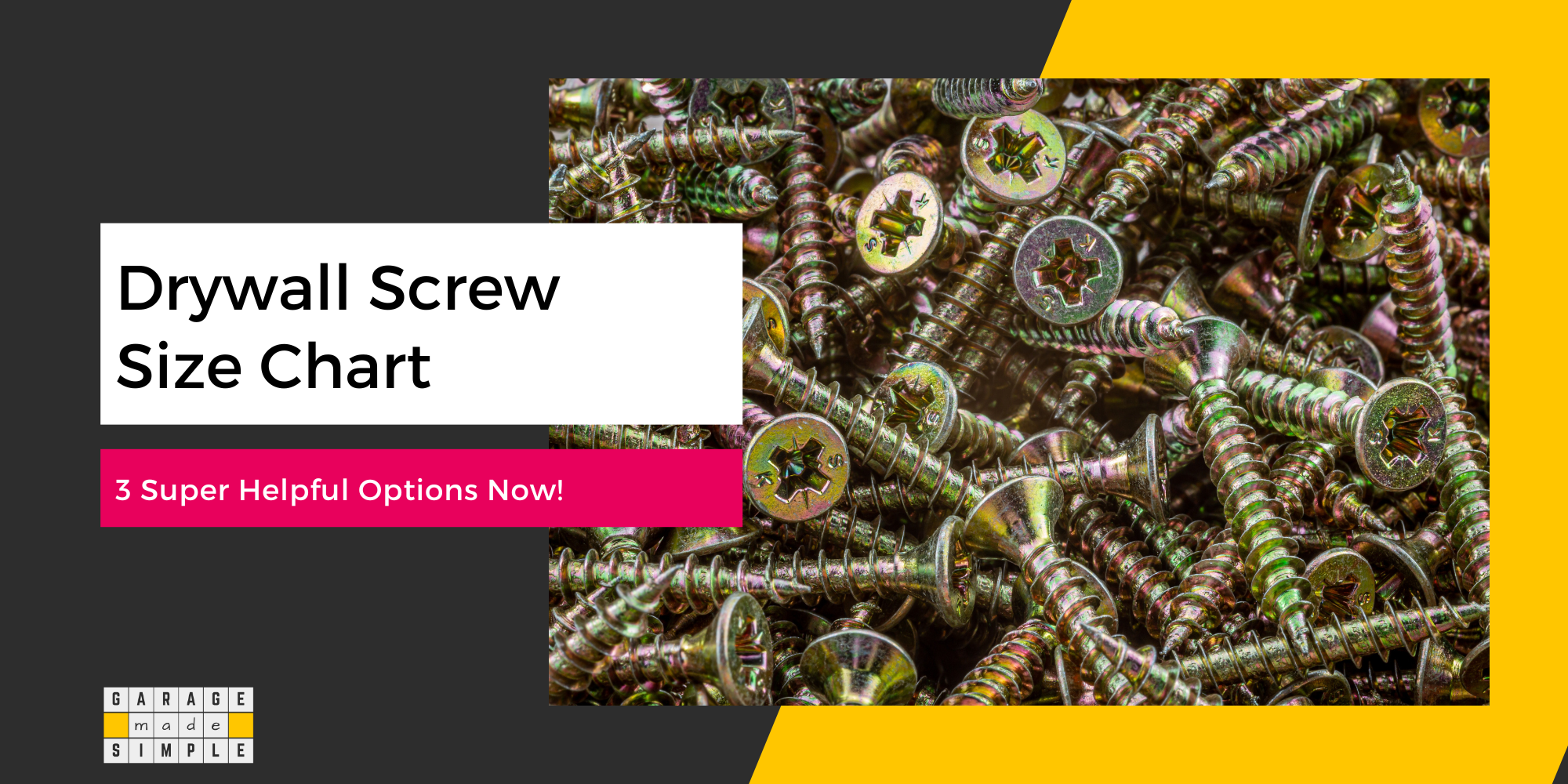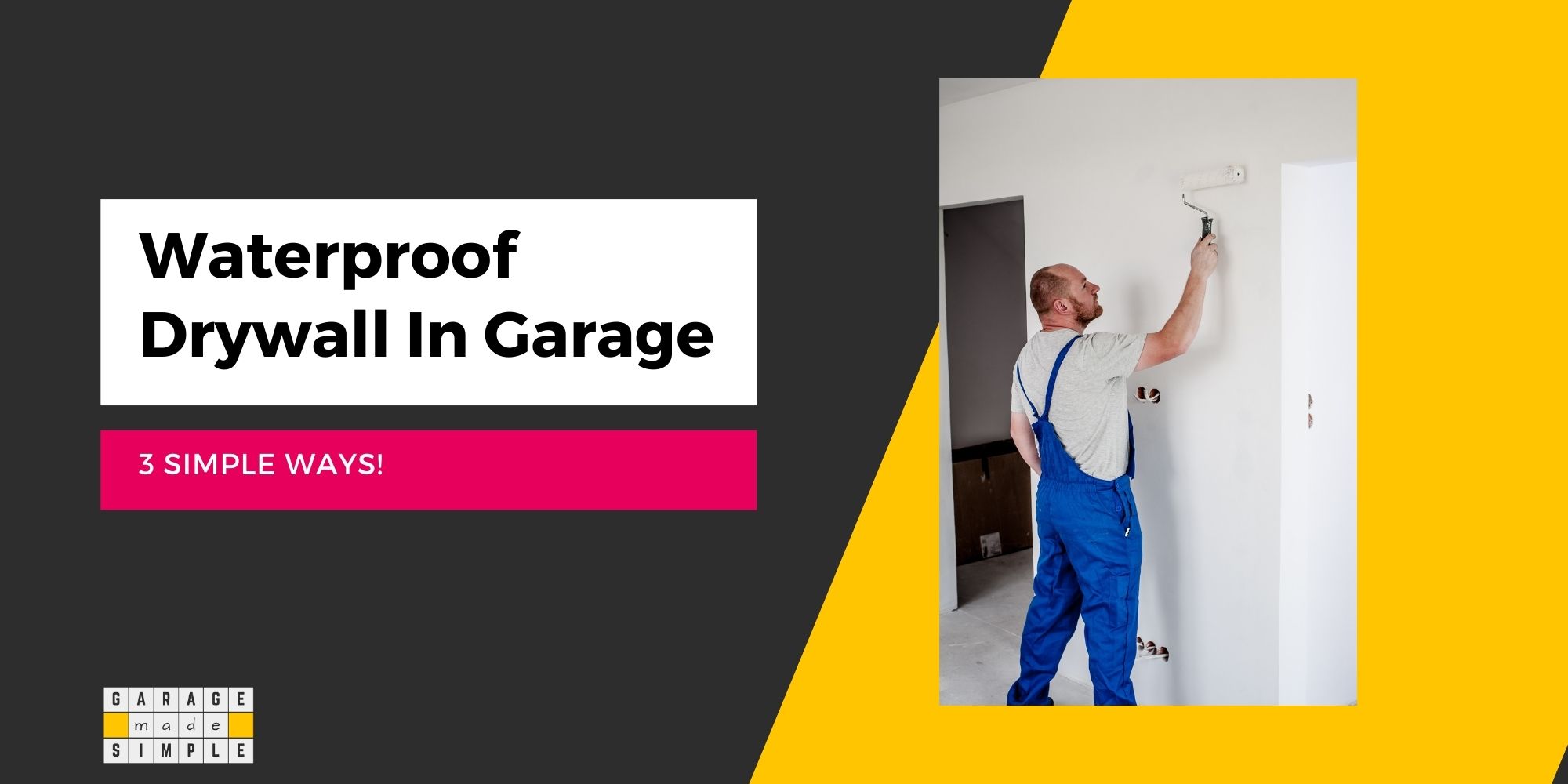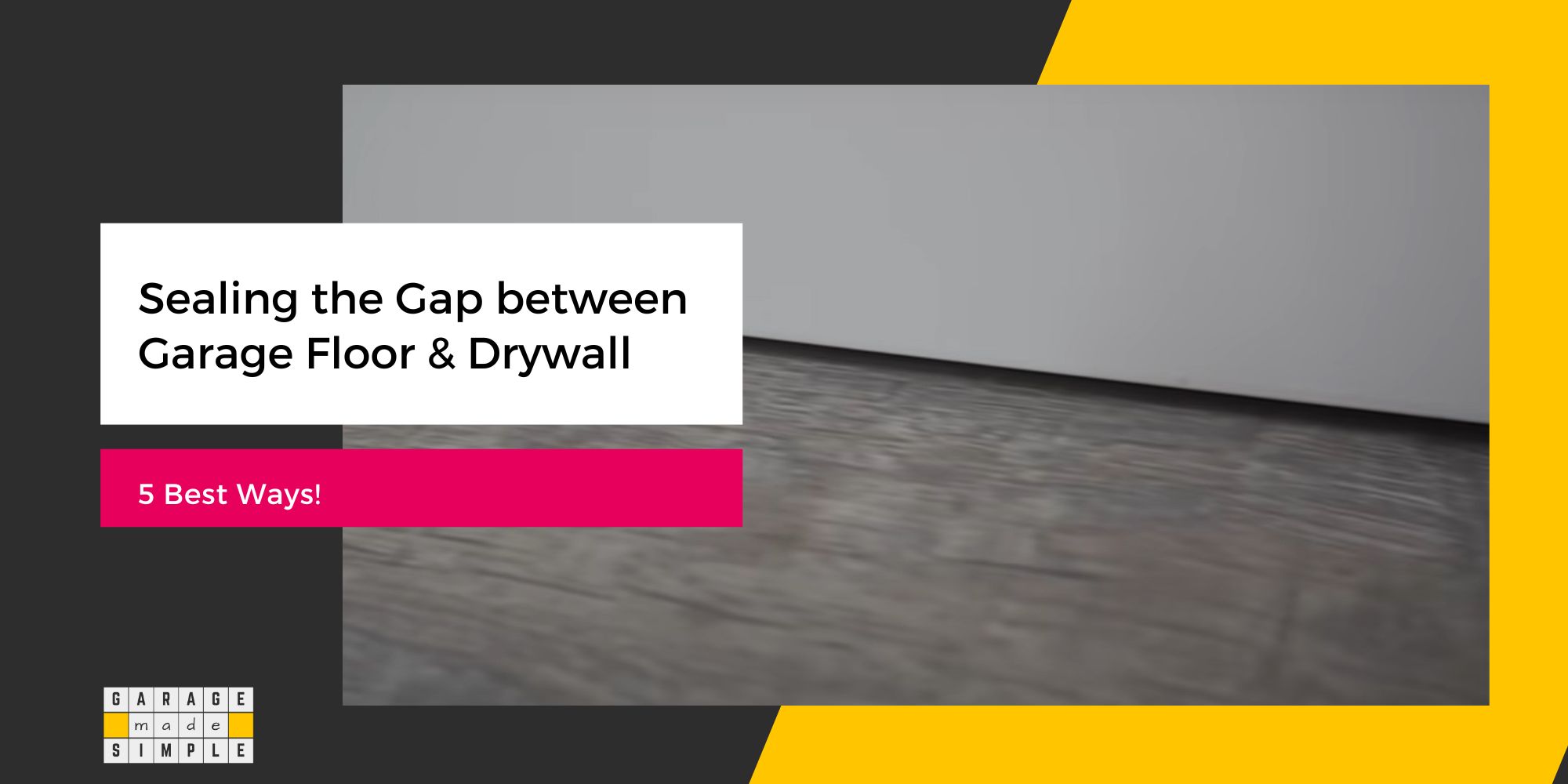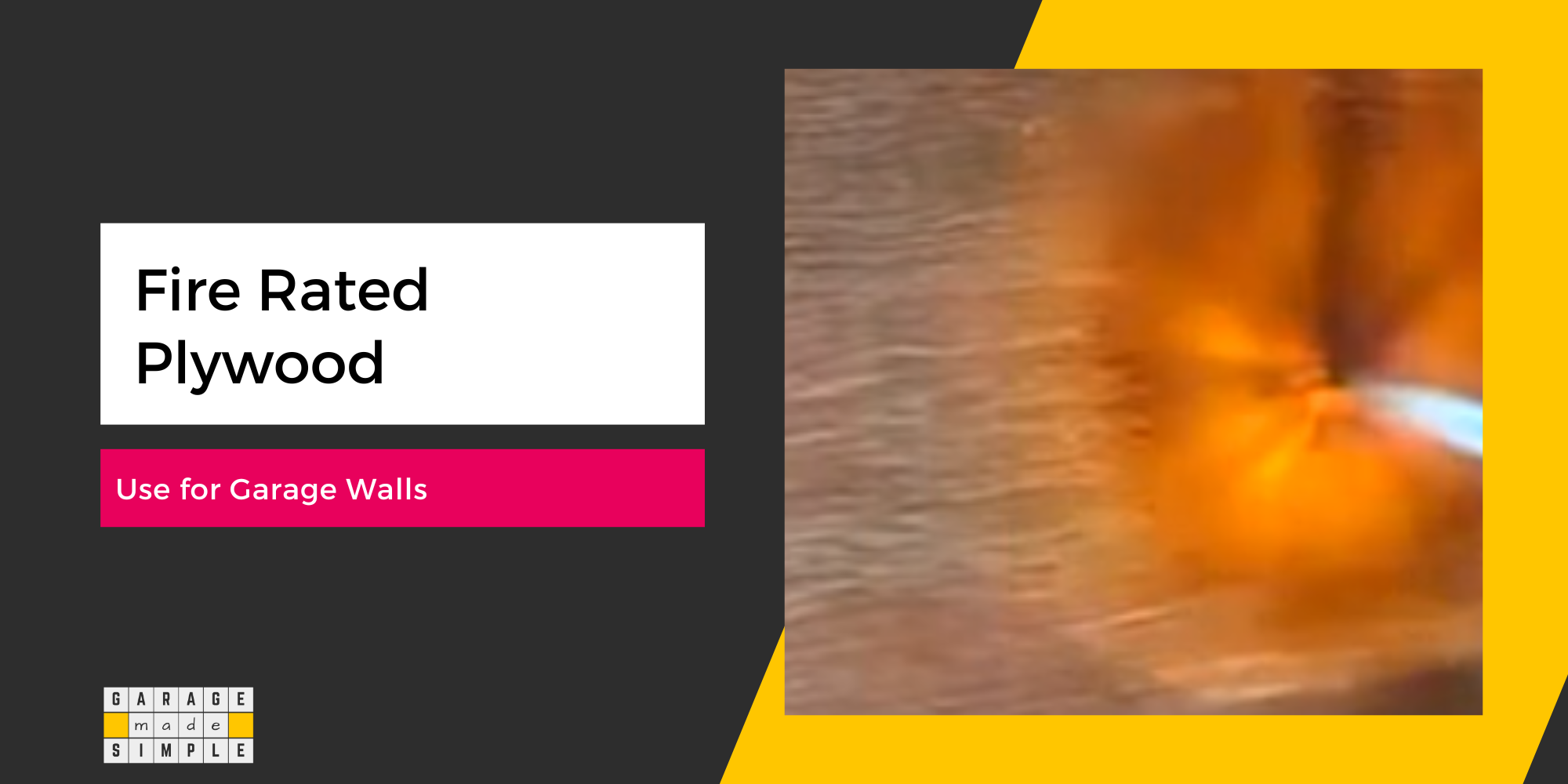Are Painted Plywood Garage Walls Better? Complete Guide
garagemadesimple.com is a participant in the Amazon Services LLC Associates Program, an affiliate advertising program designed to provide a means for sites to earn advertising fees by advertising and linking to Amazon.com . The website is also an affiliate of a few other brands.
Are Painted Plywood Garage Walls Better?
Drywall is code compliant and economical. But drywall absorbs moisture & water and gets dented quite easily. However, the code does not apply to all garage walls. In that case are painted plywood garage walls better?
Painted plywood garage walls are better than drywall on strength, impact resistance & water resistance.
Use of plywood in a detached garage will be code compliant. Use of plywood, in an attached garage, for walls that are not adjoining living space will also be code compliant. However, you need to double check with the local building code as they can differ from place to place.
In addition, painted plywood garage walls, let you make your garage a cozy and attractive living & work space.
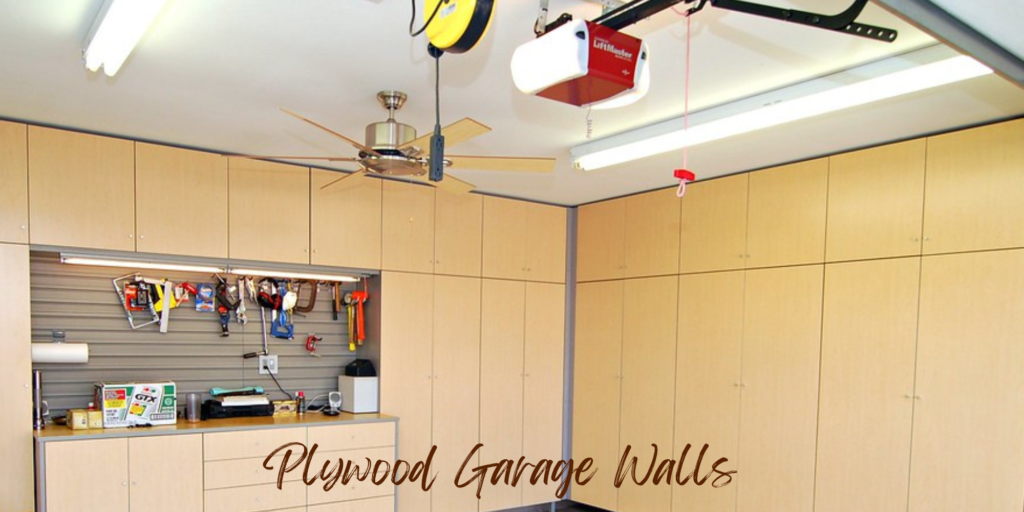
Advantages of Painted Plywood Garage Walls
Here are compelling reasons why opting for painted plywood garage walls is a smart choice:
1. Exceptional Durability: Plywood is robust and resistant to warping, ensuring it withstands wear and tear effectively.
2. Superior Strength: Plywood outperforms drywall in terms of impact resistance. Plywood is highly dent-resistant.
3. Water Resistance: Unlike drywall, plywood doesn’t succumb to moisture easily, making it a reliable choice, especially fora garage which is prone to flooding and dampness.
4. Structural Support: Plywood provides structural stability, allowing for the installation of shelves and other items securely.
5. Customizability: Plywood can be cut into various shapes and sizes, enabling tailored installations for any garage space.
6. Aesthetic Appeal: When professionally painted or stained, plywood has a natural and polished appearance, adding a touch of sophistication to your garage space.
In the comparison between drywall and plywood, the latter stands out for its strength, impact resistance, and water resilience. While drywall might be easier to install and cheaper upfront, the enduring benefits of painted plywood make it a pragmatic and sensible choice for garage walls.
For a more detailed comparison between plywood and drywall garage walls, scroll down.
Understanding Plywood & Its Key Features
Plywood is an engineered wood product. There are many types of engineered wood products such as plywood, Oriented Strand Board (OSB), MDF, Composites, etc.
Within the plywood category there are many specifications, brands and qualities, each meeting specific requirements.
1. What Are Plies in Plywood?
Plywood is made from thin veneers of wood peelings from logs. The peelings are laid out in layers. Each layer is called a “ply”.
The veneer in each layer runs at right angles to the layer above or below it, giving plywood its strength. The layers are bonded together by using adhesives, heat & pressure.
The number of plies in a plywood is an important consideration. Plywood must have at least 3 plies but can have more than 3 as long as it is an odd number, such as 5 or 7, etc.
The more the number of plies, more the strength, more the weight and more the cost of the plywood sheet or board.
2. Is Plywood a Hardwood or Softwood?
The next distinguishing feature is the type of “wood” in the plywood. At a very broad level, plywood can be made from “softwood” or “hardwood”.
Softwood
In the US, softwood plywood is generally made from Douglas Fir. Pine, Spruce, Cedar and Redwood may also be used.
An advantage of softwood plywood is that it is easier to work with. It is great for beginner DIYers. You just need basic woodworking tools and skills.
Softwood plywood is generally used either in the construction industry for structures. The plywood sheet that you are going to use for garage wall sheathing will likely be a softwood plywood.
Hardwood
Hardwood plywood may use wood shavings from ash, birch, mahogany, teak, maple & oak. Hardwood is less easily available, denser, heavier and stronger.
So plywood made from hardwood is generally used to make furniture such as cabinets, chests & built-in closets. They are also used for making doors, toys, skateboards etc.
3. What Are Exposure Ratings for Plywood?
The exposure durability classification relates to glue bond, and thus to structural integrity. Rating is an important guide for choosing the right plywood for your application.
APA approved plywood comes in 4 exposure ratings as under:
Exterior – waterproof & weatherproof
Plywood of “Exterior” rating can be used for outdoor applications and will withstand sun, rain & snow. If you are planning to make a shed in your backyard you should be using plywood of “Exterior” rating.
Exposure 1 – waterproof but not weatherproof
Plywood of “Exposure 1” rating can be used for short-term outdoor applications, such as during construction, but not for permanent structures. It is best to keep them covered with a waterproof tarp if rain or snow is expected.
Exposure 2 – moisture proof but not waterproof
Plywood of “Exposure 2” rating can be used for exterior applications provided the sheathing or the furniture has only slight exposure to moisture, but no exposure to rain. It could be used in porches, for example, in areas which are not exposed to direct rain.
Interior – not moisture proof & suitable for interior use
Plywood of “Interior” rating can be used indoors only and in dry conditions. Such plywood is not even “moisture proof”.
4. Which Grade Is Best in Plywood?
APA also grades plywood and the grading is based on the veneer finish. The grade refers to the quality and appearance of the plywood’s face and back veneers. A has the highest quality and is the most expensive, and D is the least expensive.
A-grade plywood
A-grade plywood features a smooth, sanded surface without knots. It is generally used to make furniture or cabinet doors. A-grade plywood can be painted due to it’s smooth finish and would be a good choice for painted plywood garage walls.
B-grade plywood
B-grade plywood also features a smooth, sanded surface, but may have some defects that have been patched up.
C-grade plywood
C-grade plywood is unsanded, with several minor defects & discoloration and sanding defects. C-grade plywood can be used if you are not concerned about looks or if you are going to cover it with pegboard or slatwall panels.
D-grade plywood
D-grade plywood is like C-grade plywood, only worse. That is the size of defects & discoloration is larger.

5. Can Plywood Be Fire-Resistant?
Flame Spread Rating is a test that relates to the rate at which a flame will spread along the surface of a material.
The best known flame-spread test is the “tunnel test” which has been adopted as ASTM test Standard E-84. The various regional and city building-code bodies have adopted flame-spread limitations for interior finish material based on recognized laboratory test methods.
Source: Performance Panels by APA
Plywood can be Fire Retardant Treated (FRT) or Fire Retardant Coated (FRC). The difference is that FRT plywood is pressure-impregnated with fire-retardant salts and is able to inhibit combustion.
In any case the Flame Spread Rate for both FRT & FRC softwood plywood is 25 or less.
- The lowest flame-spread rate (0 to 25) is permitted for areas where fire hazard is most severe, as in vertical exit ways of un-sprinklered buildings used for public assembly.
- Materials which rate 26 to 75 are permitted in areas of intermediate severity, such as corridors providing exit ways in commercial and industrial structures.
- Materials rated from 76 to 200 are permitted in rooms of most occupancies except hospital rooms and the like.
Source: Performance Panels by APA
Please do check and make sure with the building code in your locality to ensure you are using plywood with the correct fire rating.
Plywood vs Drywall Garage Walls (Detailed Comparison)
When it comes to garage walls, Drywall or Sheetrock is the sheathing material of choice. Actually there are 10 Reasons Why It Is Better To Drywall A Detached Garage.
However, there are still many situations where you may want to use Plywood instead.
1. Strength
Drywall is actually quite fragile and can not take any load. So if you want to hang anything on the garage wall, you have to nail or screw onto the studs only.
Plywood is strong enough to take a reasonable amount of load. So you can hang tools etc. directly on to the plywood. This could be an important factor for you for a garage wall.
2. Impact Resistance
It is very easy to punch a hole in a drywall, because it is just gypsum paste squished together between two sheets of paper. If you are not careful with your ladder at all times you will likely rip a hole through your garage drywall.
Plywood would be able to handle that hit by the ladder. You might scratch the paint or even the plywood, but it will hold. You need that kind of strength in a garage wall, where you are parking, working and storing stuff.
3. Ease of Installation
For the same thickness (5/8″) sheet of drywall weighs 2.75 pounds per square feet as compared to 1.8 to 2.1 pounds per square feet for plywood.
Both drywall and plywood typically come as 4’X8’ boards. So it is a lot easier to move a plywood board around compared to a drywall, during installation.
Cutting a drywall is a lot easier than plywood. You can do it with a utility knife. For plywood you require a power saw.
The cutting of drywall creates a lot of fine dust which carries a great distance and settles over furniture. Cleaning up can be a nightmare. The sawdust from plywood would fall straight down. A lot easier to clean up.
DEWALT Table Saw, 10 Inch, 32 ½-Inch Rip Capacity, Dust Collector, Scissor Stand
DEWALT Table Saw, 10 Inch, with Scissor Stand
The DWE7491X 10 in. Jobsite Table Saw with Scissor Stand has a 15 Amp motor and 32-1/2 in. rip capacity to allow cutting of large and hardwood materials.
Features tool-free guarding component adjustments and fast, accurate fence adjustments. Scissor stand designed for easy set up and breakdown with excellent stability.
4. Water Resistance
Drywall has very poor water resistance. If there is water leakage or seepage in your garage then the drywall will get soggy & disintegrate. You may have to even tear down the drywall and replace it completely.
Plywood can handle water much better. Even the “Interior” rated plywood. You can of course choose to use an “Exterior” rated plywood which is waterproof, or something in between
5. Fire Resistance
The 2021 edition of the International Residential Code (IRC) specifies the type of doors, adjoining walls and floor that an attached or a built-in garage should have.
R302.6 Dwelling Garage Fire Separation (applies to adjoining Garage Walls & Ceilings) states that
The garage shall be separated as required by Table R302.6. Openings in garage walls shall comply with Section R302.5. This provision does not apply to garage walls that are perpendicular to the adjacent dwelling unit wall.
Table R302.6
| Separation Material | Requirement |
| From the residence and attics | Not less than ½-inch gypsum board or equivalent applied to the garage side |
| From all habitable rooms above the garage | Not less than 5⁄8-inch Type X gypsum board or equivalent |
| Structure(s) supporting floor-ceiling assemblies used for separation required by this section | Not less than ½-inch gypsum board or equivalent |
| Garages located less than 3 feet (914 mm) from a dwelling unit on the same lot | Not less than ½-inch gypsum board or equivalent applied to the interior side of exterior walls that are within this area |
You can check out Attached Garage Fire Containment blog from International Association of Certified Home Inspectors for more details.
If the sheathing is made of drywall it will meet the building code specs. Ordinary plywood will not. Will FRT plywood meet the building code? You have to check with the local authorities.
For a climate controlled garage, the walls should be insulated. Insulation materials such as fiberglass wool or rock wool have high fire resistance.
Check if the building code in your area will accept insulation batt or SPF insulation in the stud cavities behind the plywood sheathing, as adequate fire resistance.
6. Finishing
Drywall has a smooth paper coating which is moisture resistant. Painting a drywall is rather easy as no surface preparation is required. Moreover, the moisture resistant paper coating does not absorb the paint, so you use a lot less of it.
Plywood can be finished in three different ways. Plywood can be painted to any color of your choice. It can also be stained or varnished to enhance the wood grain looks.
Some people prefer plywood because plywood can give a natural, warm feel as compared to the synthetic commercial feel of drywall.
7. Cost
The key reason drywall has become so popular is that it is a lot cheaper than plywood.
For example ToughRock 5/8-in x 4-ft x 8-ft Fireguard Moisture Resistant Fire Resistant Drywall Panel costs $ 22.98 at Lowes while a 5/8-in x 4-ft x 8-ft Douglas Fir Plywood Sheathing costs $ 60.39
Enhancing the Aesthetic Appeal of Plywood Garage Walls
You can further enhance the aesthetic appeal of plywood garage walls by one or more of the following practical and creative ways.
1. Professional Painting:
Painted plywood garage walls will result in a professional and polished look. Choose colors that complement your garage’s theme and opt for matte or semi-gloss finishes for a modern touch.
2. Decorative Finishes:
Explore decorative finishes such as faux painting, stenciling, or texture painting to add depth and character to your plywood garage walls. These techniques can create visually interesting patterns and textures.
3. Wallpaper or Wall Decals:
Apply modern wallpapers or wall decals with various patterns, textures, and colors. This quick solution instantly adds style to your garage without the hassle of traditional painting.
4. Wood Stain or Varnish:
Enhance the natural beauty of plywood by applying wood stain or varnish. These products enrich the wood grain, giving your walls a warm and rustic appearance while protecting against moisture and UV rays.
5. Paneling:
Install decorative wall paneling options like beadboard, shiplap, or tongue and groove boards on top of the plywood garage walls. These panels add texture and create a classic atmosphere, transforming the look of your garage.
6. Artwork and Murals:
Hang artwork, photographs, or murals on your plywood walls. Create a gallery wall or opt for a large mural to add a personal touch and make a bold statement in your garage.
7. Floating Shelves and Displays:
Install floating shelves or display units on the plywood walls. Use them to showcase decorative items, plants, or collectibles, adding depth and visual interest to the space.

8. Indirect Lighting:
Add LED strips or rope lights along the edges or behind shelves to create ambient lighting. Indirect lighting highlights the plywood texture and provides a subtle glow, enhancing the overall ambiance.
9. Accessorize:
Use decorative accessories like surfboards, trophies, or wall sculptures to create focal points on the plywood garage walls. Highlight the items with spot lights to draw attention.
10. Greenery:
Introduce indoor plants or vertical gardens to bring nature indoors. Plants not only purify the air but also add vibrancy to the space, making your plywood garage walls feel lively and inviting.
By incorporating these creative ideas, you can transform your garage’s plywood walls into a visually appealing backdrop. Experiment with these techniques to find the perfect combination that suits your style and enhances the overall aesthetics of your space.
How to Paint Plywood Garage Walls? Step-by-Step
Bare plywood on garage walls does not look too good. Painted Plywood Garage Walls will improve the aesthetics of your garage. You will feel a lot more comfortable and will also be able to put your garage to other uses.
Painting of newly installed plywood garage walls involves the following steps:
STEP 1: Filling out the Imperfections of Plywood
The surface of plywood is generally rough. Moreover if the plywood is grade C or Grade D it will have knot holes and other imperfections. These need to be filled out by using a good quality wood filler using a putty knife.
STEP 2: Sanding Plywood
Once the wood filler has dried you need to sand it to a smooth finish. But do not make the mistake of sanding only the portion where the wood filler has been applied.
Plywood surface is generally quite rough. If you want to be proud of the final painted plywood garage wall. you have to sand every square inch of the plywood.
DEWALT Orbital Sander
The DWE6421 5-inch Single Speed Random Orbital Sander with hook and loop pad has a 3-amp motor that delivers 12,000 OPM. The separate counterweight reduces vibration and along with the rubber overmold grip provides comfortable sanding.
A shorter design allows users to get closer to the work surface and the one-handed locking dust bag attaches securely to the sander to aid in dust collection or the user can attach the power sander directly to the DWV010 or DWV012 dust collectors.
I know it is labor intensive. But trust me the final finish will be worth it!
STEP 3: Priming Plywood is a Must
One of the biggest mistakes that many beginners make is skipping the primer coat. Skipping the primer coat may save you time, labor and some money. Or so it may seem.
The fact is skipping the primer coat will just mean you will end up using much more of the finish paint. And still the adherence will not be good and the paint may start peeling much before expected.
ZINSSER White, Bulls Eye 1-2-3 Water-Based Stain Blocking Primer/Sealer
Rust-Oleum ZINSSER Bulls Eye 1-2-3 Water-Based Stain Blocking Primer/Sealer
- Interior/exterior primer for use on new or previously painted drywall
- Water-based formula that seals uniformly
- Quick Drying
- Has excellent stain blocking resistance
- One coat hide saves time and money
STEP 4: Finally 2 Coats of Finish Paint
To cover the surface completely and to get a smooth uniform finish you need to apply at least 2 coats of the finish paint. Once again using a water base latex top coat with low sheen will give your garage a nice glow.
Please keep in mind that semi-gloss or high gloss alkyd paints will not look very good on large plywood surfaces as the gloss will highlight the imperfections or waviness of the plywood.
The garage lights will also create uncomfortable glare on the painted plywood garage walls.
Zinsser Perma-White Mold and Mildew-Proof Interior Paint
Zinsser Perma-White Mold and Mildew-Proof Interior Paint (Satin)
- Mold & Mildew-Proof™* paint film- guaranteed for 5 years
- Washable, scrubbable, stain & moisture resistant finish
- Fade Resistant
- Water-base, low odor
- Tintable to off-white, pastel and medium colors
Bottom Line
The bottom line is that both plywood and drywall can be used for garage wall sheathing. Drywall will meet the building codes. Plywood may not meet the building code, especially for walls adjacent to the living space. However, plywood will be quite suitable for a detached garage.
You must check with the local authorities before installation.
Best Features of:
| Drywall | Plywood |
| Fire Resistance | Strength |
| Ease of Installation | Impact Resistance |
| Low Cost | Water Resistance |
Thank you very much for reading the post. I do hope you found it informative and useful.






